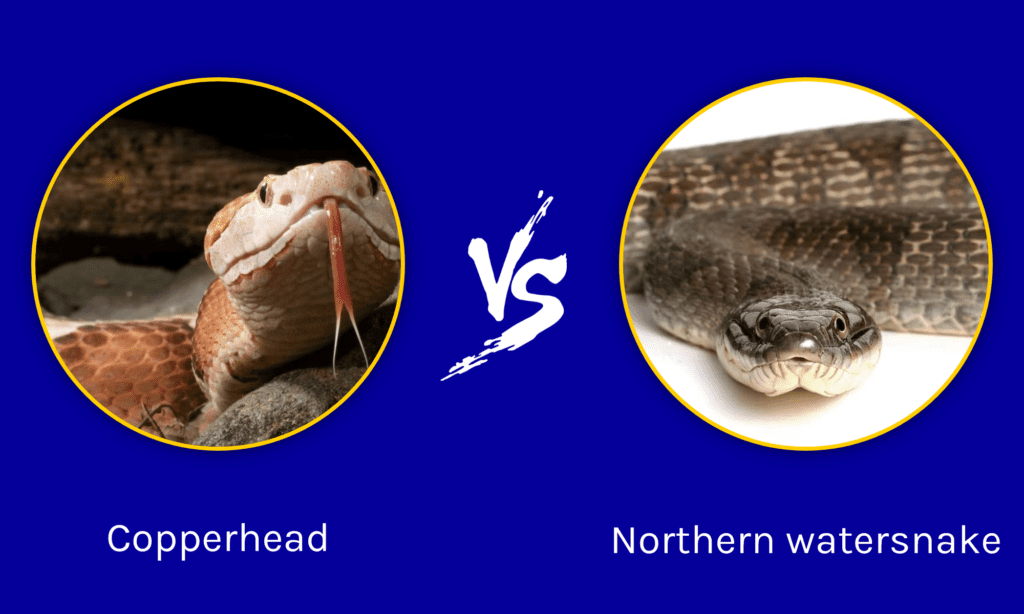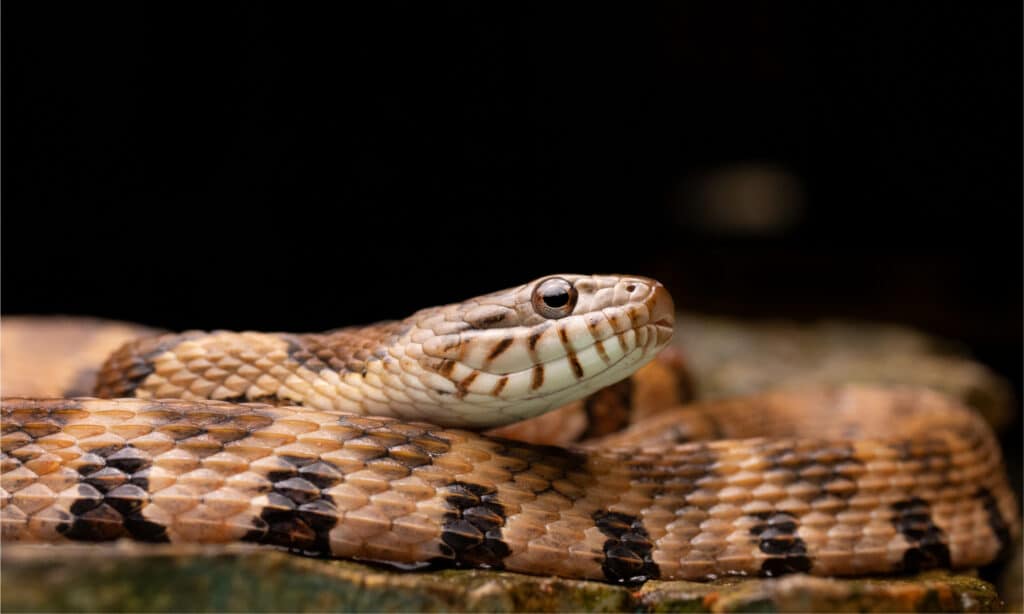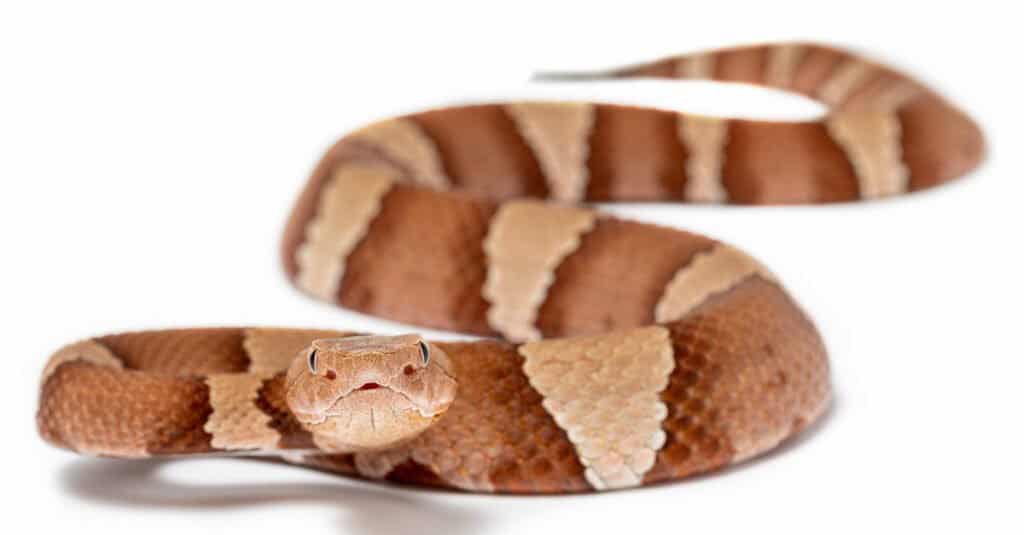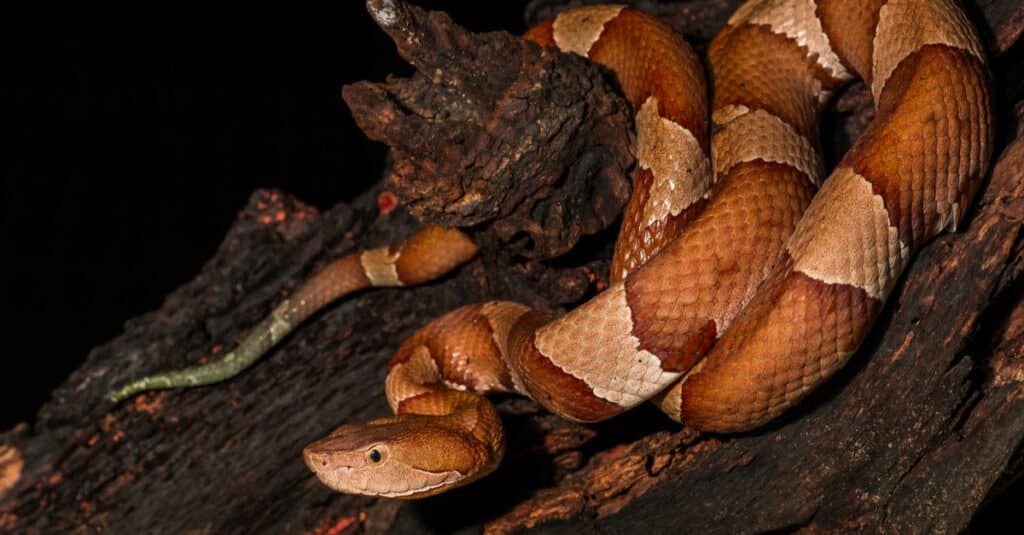North America is well-adorned with diverse snakes. The continent is said to have about 150 species of snakes. Much to everyone’s relief, only about 10% of northern America’s snakes are venomous. Two commonly-spotted snake species are the copperhead and the northern watersnake.
Both snakes have similar colors and patterns causing people with little reptile knowledge to mix them up. However, copperheads and northern watersnakes have very little in common apart from their colors. This article compares two of North America’s most common species: copperhead vs northern water snake.
Comparing Copperheads and Northern Watersnakes

| Copperhead Snake | Northern Water Snake | |
|---|---|---|
| Size | Weight: 0.2 – 0.7 pounds/ 3.2 – 11.2 ounces Length: 20-37 in/ 1.7-3.1 ft | Weight: 0.2-1.25 pounds/ 2.9 to 20 ounces Length: 27.4 – 53.1 in/ 2.2-4.4 ft |
| Venom | Venom composition: Primarily hemotoxic Symptoms of envenomation: Extreme pain, severe nausea, and swelling Maximum venom yield 85mg Average venom yield: 26mg Lethal venom yield: 85-100mg | Nonvenomous |
| Fangs | Solenoglyphous They subdue with venom before swallowing their prey whole | No fangs They have rows of teeth instead |
| Defense | Venom Musk | Nonvenomous bite Musk |
| Morphology | Copper or orange-red triangular heads Pale brown to pinkish-brown background skin Hourglass-shaped markings that are colored copper to reddish-brown Dorsal and ventral scales | 27.4 – 53.1 in/ 2.2-4.4 ft Triangular head Gray, brown, reddish-black, or brownish-black backgrounds skin Dark crossbands and blotches White, gray, or yellow bellies with black or red crescents Keeled scales with divided anal plate |
| Hunting | Pit vipers May swallow their prey whole | They swallow their prey whole |
| Location | Northern America | Northern America |
Key Differences Between the Copperhead vs Northern Watersnake
One difference is the patterns. A copperhead snake has an hourglass-shaped scale pattern, whereas the northern water snake has a bulb-shaped pattern. The other major difference between these two snake species is their venom- or the lack of it. Eastern copperheads are venomous and although they aren’t regular killers, several people have been reported to have lost their lives from their bites. Northern watersnakes, on the other hand, are entirely nonvenomous and are less dangerous than copperheads to humans. Let’s take a look at both species, feature by feature.
Copperhead vs Northern Watersnake: Size

Northern watersnakes are longer and heavier than copperheads on average.
©Radiant Reptilia/Shutterstock.com
Copperheads weigh between 3.2 – 11.2 ounces (0.2 – 0.7 pounds) while northern water snakes weigh 2.9 to 20 ounces (0.2-1.25 pounds) on average. Length-wise, copperheads measure an average of 20-37 inches (1.7-3.1 ft) while northern copperheads usually measure between 27.4 – 53.1 inches (2.2-4.4 ft). Consequently, northern watersnakes are longer and heavier than copperheads on average.
Copperhead vs Northern Watersnake: Venom

Copperheads are venomous snakes while northern watersnakes aren’t.
©Scott Delony/Shutterstock.com
The copperhead is a venomous snake with primarily hemotoxic venom. Hemotoxins affect the circulatory and respiratory systems. Copperheads’ venom damages bone and muscle tissue in the infected area. It also causes extreme pain, severe nausea, and swelling. They have a maximum venom yield of 85 mg but need 85mg to 100mg of venom to kill a person. This clearly shows that they are capable of killing a human.
However, on average, they emit only 26 mg of venom. Consequently, their bites are hardly ever fatal and if the victim receives medical treatment in time, the effects of the venom can be treated and reversed. Although copperheads bite more people than any other snake in Northern America, their bites are hardly ever fatal.
Northern watersnakes, on the other hand, are nonvenomous. This means that they have teeth instead of fangs and have no venom at all.
Copperhead vs Northern Watersnake: Fangs
Copperheads have long solenoglyphous fangs. This means that their fangs work similarly to hypodermic needles that let them inject venom. Water snakes, however, do not have fangs but have curved teeth that help them lock in struggling animals.
Copperhead vs Northern Watersnake: Defense
Watersnakes might be nonvenomous, but they aren’t defenseless. Despite their lack of fangs, they have curved teeth that bite rather painfully. They also spray attackers with musk which they sometimes mix with feces. They are perfectly capable of protecting themselves in the wild.
Copperheads not only have hemotoxic venom but also have musk which they use to defend themselves. A lot of people claim that copperheads’ musk smells like cucumbers. However, this isn’t exactly possible as cucumbers smell nice and snake musk smells revolting.
Copperhead vs Northern Watersnake: Morphology
Copperheads and watersnakes do not look alike. However, if you’re new to the world of reptiles, they could confuse you- especially because of their coloring. Copperheads have pale brown to pinkish-brown background skin, while northern watersnakes have gray, brown, reddish-black, or brownish-black background skin.
Both snakes have markings but northern watersnakes’ markings are known to fade as they age. Copperheads have hourglass-shaped markings that are colored copper to reddish-brown. Northern copperheads, however, have dark blotches across their bodies. They also have keeled scales with divided anal plates.
Both snakes have triangular heads, but copperheads’ are colored orange or copper, while northern watersnakes’ are colored according to their skin color. It is also worth noting that watersnakes flatten their heads when threatened.
Copperhead vs Northern Watersnake: Hunting

Copperheads and watersnakes swallow their prey, although copperheads first subdue them with venom.
©Wildvet/Shutterstock.com
Northern watersnakes and copperheads are adept hunters. Copperheads are pit vipers meaning that they have heat-sensing pits that help them detect the presence and movements of their prey. With or without venom, they capture prey using different methods.
Copperheads lock their prey in their jaws while they inject them with venom. If the prey is large, they will let it go as soon as they are done injecting venom. They allow their venom to weaken the prey before finishing the job. However, if the prey is small, they will hold on to it within their jaws until it stops moving.
Northern watersnakes are nonvenomous. However, they aren’t constrictors either. They swallow their prey whole! Once they have their prey in their mouths, they close their mouths and lock their jaws around them, imprisoning them.
Copperhead vs Northern Watersnake: Location
Both snakes are found in Northern America. It is important to know that there are Asian and Australian copperheads but they aren’t related to American copperheads. In North America, they are widespread and are found in mixed woodlands and deciduous forests. They are commonly found hidden beneath rocks or ledges.
Watersnakes are found in streams, ponds, and lakes. Generally, they prefer wetlands close to a body of water.
The photo featured at the top of this post is © outdoorsman/Shutterstock.com
Discover the "Monster" Snake 5X Bigger than an Anaconda
Every day A-Z Animals sends out some of the most incredible facts in the world from our free newsletter. Want to discover the 10 most beautiful snakes in the world, a "snake island" where you're never more than 3 feet from danger, or a "monster" snake 5X larger than an anaconda? Then sign up right now and you'll start receiving our daily newsletter absolutely free.
Thank you for reading! Have some feedback for us? Contact the AZ Animals editorial team.






